Analysis of Decision-Making Theories in Nursing Practice
VerifiedAdded on 2020/12/30
|12
|3942
|229
Essay
AI Summary
This essay delves into the critical role of decision-making theories in nursing practice, focusing on how practitioners determine the best course of action for patient care. The essay examines three key theories: cognitive continuum, expected utility, and social judgment, highlighting their significance in addressing diverse patient backgrounds and beliefs. The cognitive continuum theory emphasizes collaborative decision-making within healthcare teams to reduce medical errors, particularly in emergency scenarios like post-exposure prophylaxis (PEP). Expected utility theory addresses decision-making in uncertain environments, focusing on assessing potential outcomes before interventions. Social judgment theory explores the process of making quick judgments, especially in emergency situations. Through the analysis of these theories, the essay aims to provide nurses with a comprehensive understanding of how to apply different decision-making frameworks to improve patient care and outcomes.
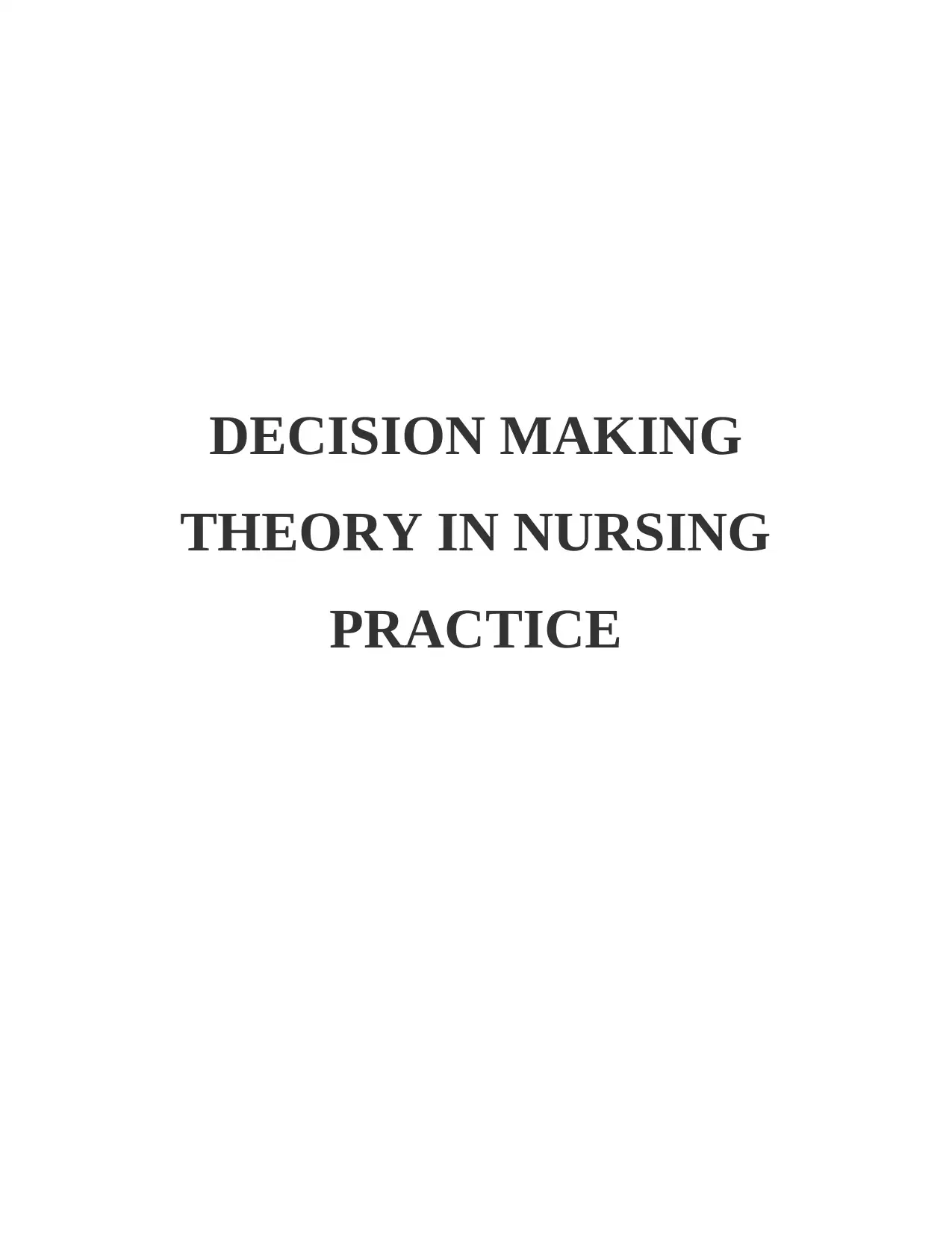
DECISION MAKING
THEORY IN NURSING
PRACTICE
THEORY IN NURSING
PRACTICE
Paraphrase This Document
Need a fresh take? Get an instant paraphrase of this document with our AI Paraphraser
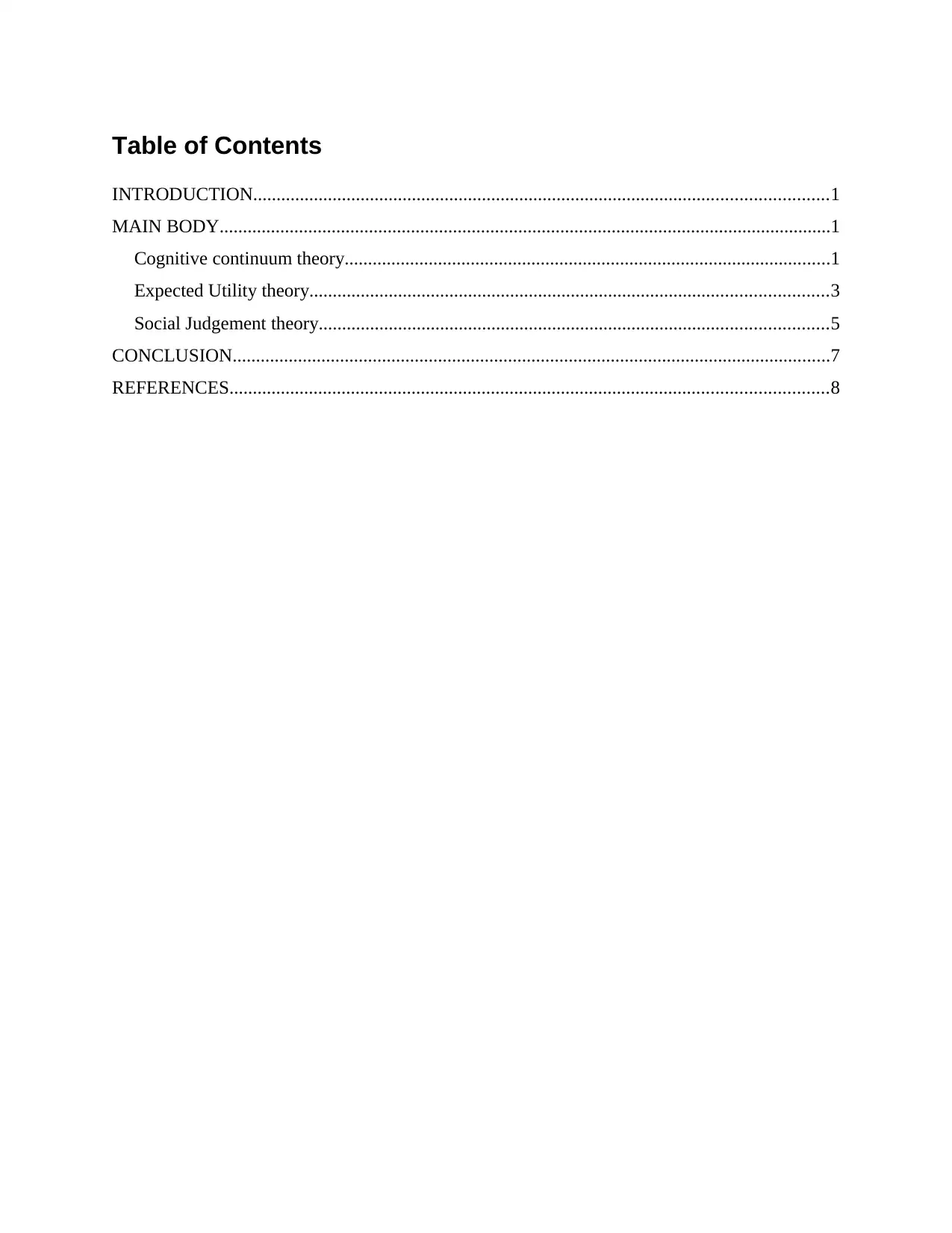
Table of Contents
INTRODUCTION...........................................................................................................................1
MAIN BODY...................................................................................................................................1
Cognitive continuum theory........................................................................................................1
Expected Utility theory...............................................................................................................3
Social Judgement theory.............................................................................................................5
CONCLUSION................................................................................................................................7
REFERENCES................................................................................................................................8
INTRODUCTION...........................................................................................................................1
MAIN BODY...................................................................................................................................1
Cognitive continuum theory........................................................................................................1
Expected Utility theory...............................................................................................................3
Social Judgement theory.............................................................................................................5
CONCLUSION................................................................................................................................7
REFERENCES................................................................................................................................8
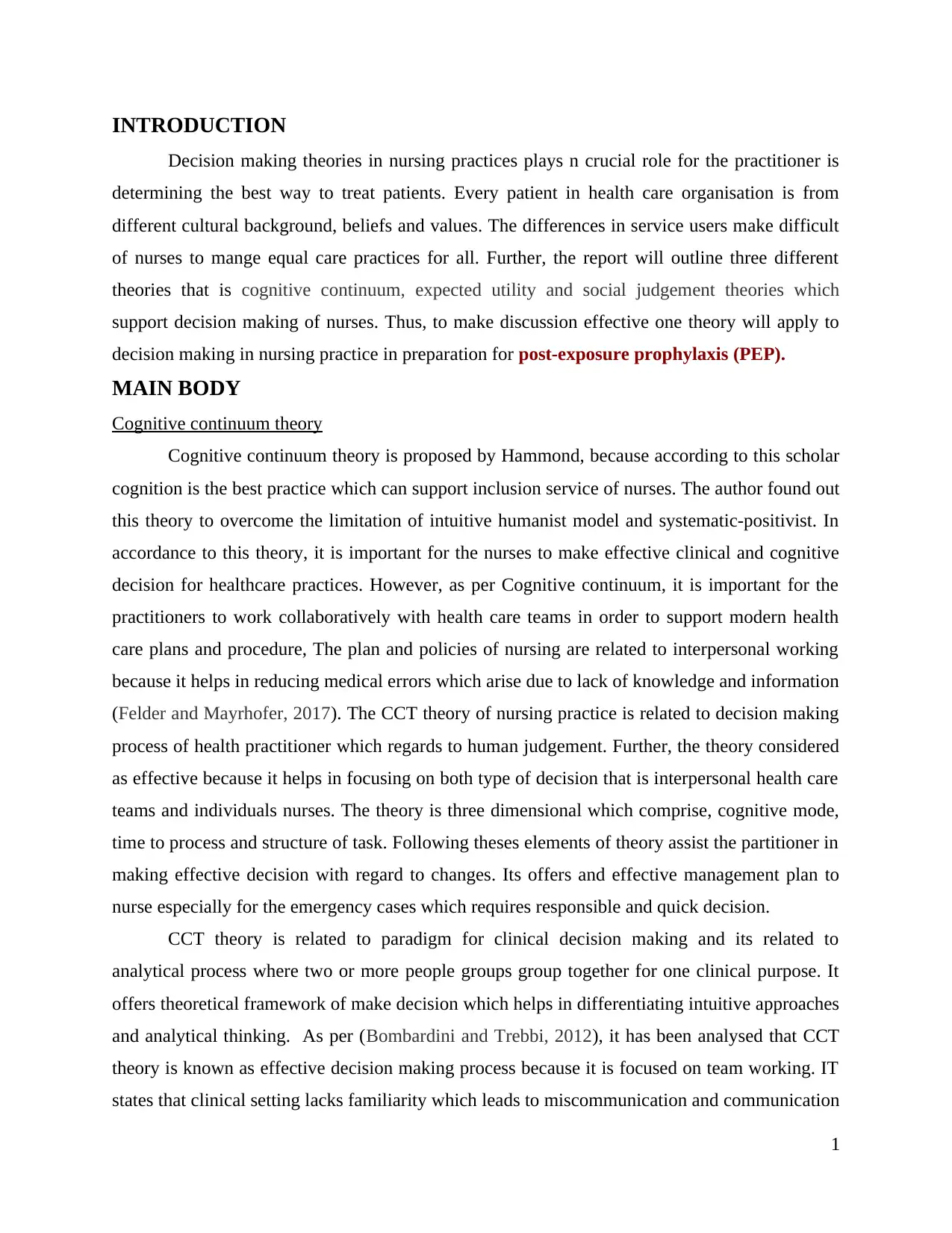
INTRODUCTION
Decision making theories in nursing practices plays n crucial role for the practitioner is
determining the best way to treat patients. Every patient in health care organisation is from
different cultural background, beliefs and values. The differences in service users make difficult
of nurses to mange equal care practices for all. Further, the report will outline three different
theories that is cognitive continuum, expected utility and social judgement theories which
support decision making of nurses. Thus, to make discussion effective one theory will apply to
decision making in nursing practice in preparation for post-exposure prophylaxis (PEP).
MAIN BODY
Cognitive continuum theory
Cognitive continuum theory is proposed by Hammond, because according to this scholar
cognition is the best practice which can support inclusion service of nurses. The author found out
this theory to overcome the limitation of intuitive humanist model and systematic-positivist. In
accordance to this theory, it is important for the nurses to make effective clinical and cognitive
decision for healthcare practices. However, as per Cognitive continuum, it is important for the
practitioners to work collaboratively with health care teams in order to support modern health
care plans and procedure, The plan and policies of nursing are related to interpersonal working
because it helps in reducing medical errors which arise due to lack of knowledge and information
(Felder and Mayrhofer, 2017). The CCT theory of nursing practice is related to decision making
process of health practitioner which regards to human judgement. Further, the theory considered
as effective because it helps in focusing on both type of decision that is interpersonal health care
teams and individuals nurses. The theory is three dimensional which comprise, cognitive mode,
time to process and structure of task. Following theses elements of theory assist the partitioner in
making effective decision with regard to changes. Its offers and effective management plan to
nurse especially for the emergency cases which requires responsible and quick decision.
CCT theory is related to paradigm for clinical decision making and its related to
analytical process where two or more people groups group together for one clinical purpose. It
offers theoretical framework of make decision which helps in differentiating intuitive approaches
and analytical thinking. As per (Bombardini and Trebbi, 2012), it has been analysed that CCT
theory is known as effective decision making process because it is focused on team working. IT
states that clinical setting lacks familiarity which leads to miscommunication and communication
1
Decision making theories in nursing practices plays n crucial role for the practitioner is
determining the best way to treat patients. Every patient in health care organisation is from
different cultural background, beliefs and values. The differences in service users make difficult
of nurses to mange equal care practices for all. Further, the report will outline three different
theories that is cognitive continuum, expected utility and social judgement theories which
support decision making of nurses. Thus, to make discussion effective one theory will apply to
decision making in nursing practice in preparation for post-exposure prophylaxis (PEP).
MAIN BODY
Cognitive continuum theory
Cognitive continuum theory is proposed by Hammond, because according to this scholar
cognition is the best practice which can support inclusion service of nurses. The author found out
this theory to overcome the limitation of intuitive humanist model and systematic-positivist. In
accordance to this theory, it is important for the nurses to make effective clinical and cognitive
decision for healthcare practices. However, as per Cognitive continuum, it is important for the
practitioners to work collaboratively with health care teams in order to support modern health
care plans and procedure, The plan and policies of nursing are related to interpersonal working
because it helps in reducing medical errors which arise due to lack of knowledge and information
(Felder and Mayrhofer, 2017). The CCT theory of nursing practice is related to decision making
process of health practitioner which regards to human judgement. Further, the theory considered
as effective because it helps in focusing on both type of decision that is interpersonal health care
teams and individuals nurses. The theory is three dimensional which comprise, cognitive mode,
time to process and structure of task. Following theses elements of theory assist the partitioner in
making effective decision with regard to changes. Its offers and effective management plan to
nurse especially for the emergency cases which requires responsible and quick decision.
CCT theory is related to paradigm for clinical decision making and its related to
analytical process where two or more people groups group together for one clinical purpose. It
offers theoretical framework of make decision which helps in differentiating intuitive approaches
and analytical thinking. As per (Bombardini and Trebbi, 2012), it has been analysed that CCT
theory is known as effective decision making process because it is focused on team working. IT
states that clinical setting lacks familiarity which leads to miscommunication and communication
1
⊘ This is a preview!⊘
Do you want full access?
Subscribe today to unlock all pages.

Trusted by 1+ million students worldwide

gap. However, it assists the nurses in setting collaborative working which helps in overcoming
each other weakness. It is an effective plan because there are nurses who lack pharmacology
knowledge, quick decision making etc. which are assisted in cognitive approach of working.
Apart from interpersonal working, CCT approach is helpful for the individual nurses in
managing effective decision post-exposure prophylaxis because the theory supports inclusion
and helps the practitioner in deriving unique way of involving service users in order to deliver
safe and quality patient care services. The major advantage of implementing use of this theory is
in decision making of nurses where it helps in reducing medical and clinical errors (Kam,
Chismar and Thomas, 2014). Thus, from the analysis it can be said that the theory can be
effective for post-exposure prophylaxis. PEP is an critical medication situation where nurses
needs to be focused on pharma knowledge and confide of individuals when dealing patients.
Moreover, it will be beneficial as it is related to interpersonal team working in health care
organisation. Hence, it is important for the person to develop knowledge over cognitive
continuum practises as it is related to enhancing one's knowledge over medical services which
are patient centred. Involving effectively with patient to which post-exposure prophylaxis is
being given is the most effective plan which is supported by cognitive approach of this theory.
For instance, if in case the team of 5 health practitioner are allotted work in team for
managing decision for the patient who has been exposed to HIV and within 72 hours he needs to
be given PEP, in this case the focus practitioner will be on protecting the person by collaborating
efforts like one will focus on knowledge constraints in order to manage preventive and cautious
measure. One person will be focused on time management and other three will focus on giving
treatment by motivating patients. The collaborative efforts of nurses demonstrate working and
decision making via Cognitive continuum theory
As per (The use of cognitive continuum theory and patient scenarios to explore nurse
prescribers' pharmacological knowledge and decision-making, 2008), article where the scholar
conducted interview for using CCT to explore decision making and pharmacological knowledge
of nurses. Nevertheless, the study denotes that majority of participants were unable to answer
question for the case studies and proposed scenario, Few individuals were very confident to their
solution to problems whereas there were respondents who stated that at the time of critical
decision making the individuals refer patient to general practitioner. Thus, from the study, it has
been evaluated that social and institutional factors plays an important role decision making of
2
each other weakness. It is an effective plan because there are nurses who lack pharmacology
knowledge, quick decision making etc. which are assisted in cognitive approach of working.
Apart from interpersonal working, CCT approach is helpful for the individual nurses in
managing effective decision post-exposure prophylaxis because the theory supports inclusion
and helps the practitioner in deriving unique way of involving service users in order to deliver
safe and quality patient care services. The major advantage of implementing use of this theory is
in decision making of nurses where it helps in reducing medical and clinical errors (Kam,
Chismar and Thomas, 2014). Thus, from the analysis it can be said that the theory can be
effective for post-exposure prophylaxis. PEP is an critical medication situation where nurses
needs to be focused on pharma knowledge and confide of individuals when dealing patients.
Moreover, it will be beneficial as it is related to interpersonal team working in health care
organisation. Hence, it is important for the person to develop knowledge over cognitive
continuum practises as it is related to enhancing one's knowledge over medical services which
are patient centred. Involving effectively with patient to which post-exposure prophylaxis is
being given is the most effective plan which is supported by cognitive approach of this theory.
For instance, if in case the team of 5 health practitioner are allotted work in team for
managing decision for the patient who has been exposed to HIV and within 72 hours he needs to
be given PEP, in this case the focus practitioner will be on protecting the person by collaborating
efforts like one will focus on knowledge constraints in order to manage preventive and cautious
measure. One person will be focused on time management and other three will focus on giving
treatment by motivating patients. The collaborative efforts of nurses demonstrate working and
decision making via Cognitive continuum theory
As per (The use of cognitive continuum theory and patient scenarios to explore nurse
prescribers' pharmacological knowledge and decision-making, 2008), article where the scholar
conducted interview for using CCT to explore decision making and pharmacological knowledge
of nurses. Nevertheless, the study denotes that majority of participants were unable to answer
question for the case studies and proposed scenario, Few individuals were very confident to their
solution to problems whereas there were respondents who stated that at the time of critical
decision making the individuals refer patient to general practitioner. Thus, from the study, it has
been evaluated that social and institutional factors plays an important role decision making of
2
Paraphrase This Document
Need a fresh take? Get an instant paraphrase of this document with our AI Paraphraser
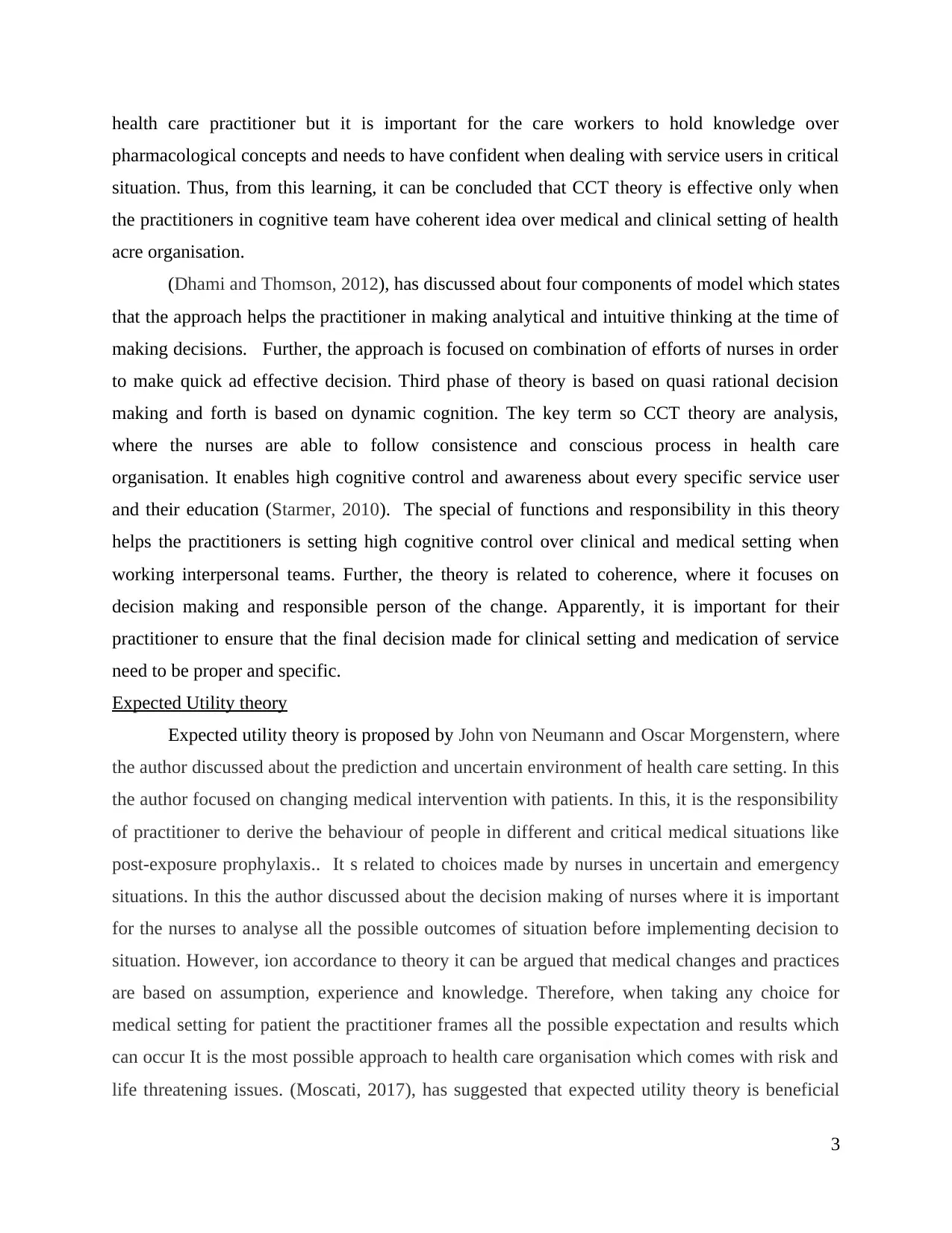
health care practitioner but it is important for the care workers to hold knowledge over
pharmacological concepts and needs to have confident when dealing with service users in critical
situation. Thus, from this learning, it can be concluded that CCT theory is effective only when
the practitioners in cognitive team have coherent idea over medical and clinical setting of health
acre organisation.
(Dhami and Thomson, 2012), has discussed about four components of model which states
that the approach helps the practitioner in making analytical and intuitive thinking at the time of
making decisions. Further, the approach is focused on combination of efforts of nurses in order
to make quick ad effective decision. Third phase of theory is based on quasi rational decision
making and forth is based on dynamic cognition. The key term so CCT theory are analysis,
where the nurses are able to follow consistence and conscious process in health care
organisation. It enables high cognitive control and awareness about every specific service user
and their education (Starmer, 2010). The special of functions and responsibility in this theory
helps the practitioners is setting high cognitive control over clinical and medical setting when
working interpersonal teams. Further, the theory is related to coherence, where it focuses on
decision making and responsible person of the change. Apparently, it is important for their
practitioner to ensure that the final decision made for clinical setting and medication of service
need to be proper and specific.
Expected Utility theory
Expected utility theory is proposed by John von Neumann and Oscar Morgenstern, where
the author discussed about the prediction and uncertain environment of health care setting. In this
the author focused on changing medical intervention with patients. In this, it is the responsibility
of practitioner to derive the behaviour of people in different and critical medical situations like
post-exposure prophylaxis.. It s related to choices made by nurses in uncertain and emergency
situations. In this the author discussed about the decision making of nurses where it is important
for the nurses to analyse all the possible outcomes of situation before implementing decision to
situation. However, ion accordance to theory it can be argued that medical changes and practices
are based on assumption, experience and knowledge. Therefore, when taking any choice for
medical setting for patient the practitioner frames all the possible expectation and results which
can occur It is the most possible approach to health care organisation which comes with risk and
life threatening issues. (Moscati, 2017), has suggested that expected utility theory is beneficial
3
pharmacological concepts and needs to have confident when dealing with service users in critical
situation. Thus, from this learning, it can be concluded that CCT theory is effective only when
the practitioners in cognitive team have coherent idea over medical and clinical setting of health
acre organisation.
(Dhami and Thomson, 2012), has discussed about four components of model which states
that the approach helps the practitioner in making analytical and intuitive thinking at the time of
making decisions. Further, the approach is focused on combination of efforts of nurses in order
to make quick ad effective decision. Third phase of theory is based on quasi rational decision
making and forth is based on dynamic cognition. The key term so CCT theory are analysis,
where the nurses are able to follow consistence and conscious process in health care
organisation. It enables high cognitive control and awareness about every specific service user
and their education (Starmer, 2010). The special of functions and responsibility in this theory
helps the practitioners is setting high cognitive control over clinical and medical setting when
working interpersonal teams. Further, the theory is related to coherence, where it focuses on
decision making and responsible person of the change. Apparently, it is important for their
practitioner to ensure that the final decision made for clinical setting and medication of service
need to be proper and specific.
Expected Utility theory
Expected utility theory is proposed by John von Neumann and Oscar Morgenstern, where
the author discussed about the prediction and uncertain environment of health care setting. In this
the author focused on changing medical intervention with patients. In this, it is the responsibility
of practitioner to derive the behaviour of people in different and critical medical situations like
post-exposure prophylaxis.. It s related to choices made by nurses in uncertain and emergency
situations. In this the author discussed about the decision making of nurses where it is important
for the nurses to analyse all the possible outcomes of situation before implementing decision to
situation. However, ion accordance to theory it can be argued that medical changes and practices
are based on assumption, experience and knowledge. Therefore, when taking any choice for
medical setting for patient the practitioner frames all the possible expectation and results which
can occur It is the most possible approach to health care organisation which comes with risk and
life threatening issues. (Moscati, 2017), has suggested that expected utility theory is beneficial
3
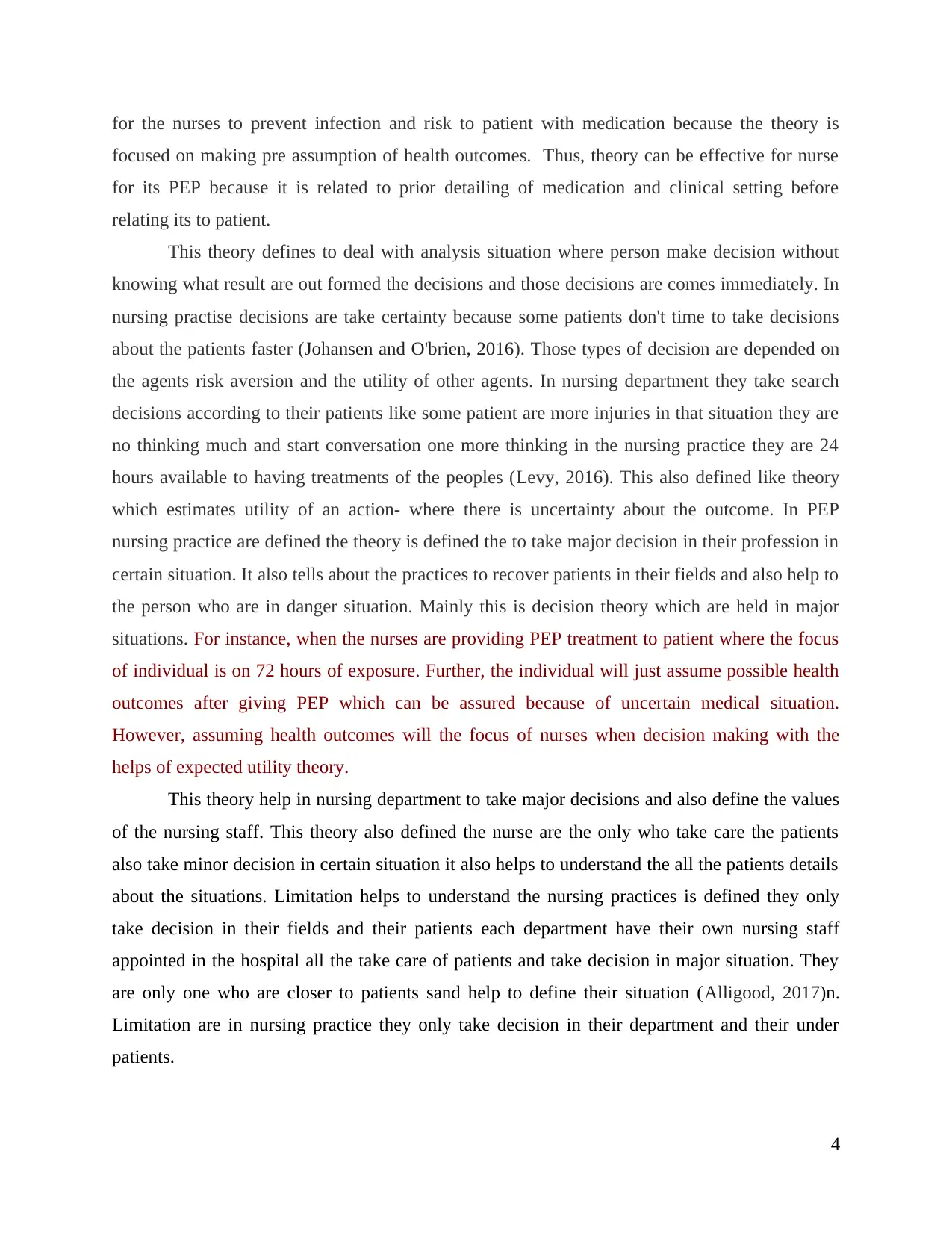
for the nurses to prevent infection and risk to patient with medication because the theory is
focused on making pre assumption of health outcomes. Thus, theory can be effective for nurse
for its PEP because it is related to prior detailing of medication and clinical setting before
relating its to patient.
This theory defines to deal with analysis situation where person make decision without
knowing what result are out formed the decisions and those decisions are comes immediately. In
nursing practise decisions are take certainty because some patients don't time to take decisions
about the patients faster (Johansen and O'brien, 2016). Those types of decision are depended on
the agents risk aversion and the utility of other agents. In nursing department they take search
decisions according to their patients like some patient are more injuries in that situation they are
no thinking much and start conversation one more thinking in the nursing practice they are 24
hours available to having treatments of the peoples (Levy, 2016). This also defined like theory
which estimates utility of an action- where there is uncertainty about the outcome. In PEP
nursing practice are defined the theory is defined the to take major decision in their profession in
certain situation. It also tells about the practices to recover patients in their fields and also help to
the person who are in danger situation. Mainly this is decision theory which are held in major
situations. For instance, when the nurses are providing PEP treatment to patient where the focus
of individual is on 72 hours of exposure. Further, the individual will just assume possible health
outcomes after giving PEP which can be assured because of uncertain medical situation.
However, assuming health outcomes will the focus of nurses when decision making with the
helps of expected utility theory.
This theory help in nursing department to take major decisions and also define the values
of the nursing staff. This theory also defined the nurse are the only who take care the patients
also take minor decision in certain situation it also helps to understand the all the patients details
about the situations. Limitation helps to understand the nursing practices is defined they only
take decision in their fields and their patients each department have their own nursing staff
appointed in the hospital all the take care of patients and take decision in major situation. They
are only one who are closer to patients sand help to define their situation (Alligood, 2017)n.
Limitation are in nursing practice they only take decision in their department and their under
patients.
4
focused on making pre assumption of health outcomes. Thus, theory can be effective for nurse
for its PEP because it is related to prior detailing of medication and clinical setting before
relating its to patient.
This theory defines to deal with analysis situation where person make decision without
knowing what result are out formed the decisions and those decisions are comes immediately. In
nursing practise decisions are take certainty because some patients don't time to take decisions
about the patients faster (Johansen and O'brien, 2016). Those types of decision are depended on
the agents risk aversion and the utility of other agents. In nursing department they take search
decisions according to their patients like some patient are more injuries in that situation they are
no thinking much and start conversation one more thinking in the nursing practice they are 24
hours available to having treatments of the peoples (Levy, 2016). This also defined like theory
which estimates utility of an action- where there is uncertainty about the outcome. In PEP
nursing practice are defined the theory is defined the to take major decision in their profession in
certain situation. It also tells about the practices to recover patients in their fields and also help to
the person who are in danger situation. Mainly this is decision theory which are held in major
situations. For instance, when the nurses are providing PEP treatment to patient where the focus
of individual is on 72 hours of exposure. Further, the individual will just assume possible health
outcomes after giving PEP which can be assured because of uncertain medical situation.
However, assuming health outcomes will the focus of nurses when decision making with the
helps of expected utility theory.
This theory help in nursing department to take major decisions and also define the values
of the nursing staff. This theory also defined the nurse are the only who take care the patients
also take minor decision in certain situation it also helps to understand the all the patients details
about the situations. Limitation helps to understand the nursing practices is defined they only
take decision in their fields and their patients each department have their own nursing staff
appointed in the hospital all the take care of patients and take decision in major situation. They
are only one who are closer to patients sand help to define their situation (Alligood, 2017)n.
Limitation are in nursing practice they only take decision in their department and their under
patients.
4
⊘ This is a preview!⊘
Do you want full access?
Subscribe today to unlock all pages.

Trusted by 1+ million students worldwide

Advantages of this theory help to take decision in critical situation its beneficial for the
patients and also beneficial in their career. This theory also give advantage in patients treatments
like they recover fast and also the critical decision are help to save patient life and also help
treatment (Cunningham and et.al., 2014). This theory helps to understand the preparing of
personal experience like those decision are help to improve confidence to take certain decisions
in the medical department and nursing department capable to take major decision in their fields
(Paterson and et.al., 2016).
Apart from this, this theory has less disadvantage but some time nursing departments
critical decisions are risk in the hospitals patients are not handled those treatments and they are
died ll those blames' arr goes to the nursing department who take decision in major situation. It
difficult but its true in nursing department. One more disadvantage to this theory in nursing
department each decisions are only demands on the situation on when factors are not in the
hospital or they are in hospital and nurses ignore them and they take decisions. In this situation
major effects goes to patient health.
Social Judgement theory
Social judgement theory is proposed by self-persuasion theory proposed by Carolyn
Sherif, Muzafer Sherif, and Carl Hovlan. The theory offers the most effective plan to
practitioners because in with the help of this theory the nurses are able to make medical
judgements. The theory is beneficial for PEP experience because it is important for the
practitioner to make me quick judgement to emergency situation in order to prevent risk of
uncertain medical situation. Apparently, it is related to judgement which arise in risky situation
like inevitable error, abundance of fallible cues etc. Like PEP which is given to patient in
emergency situation with 72 hours. In accordance to this situation it can be said that it is
important for the nurses to make quick decision in order to prevent the risk of lapse. The nursing
decision making accordance to social judgement theory varies from patient to patients and also
with changes in clinical setting (Dowding and Thompson, 2017). As per social theory, it has
been analysed that the medical judgement are instant and for making decision this theory support
easy analysis. Accordance, to this procedure the individuals holds knowledge and experience of
every medical situation and risks therefore as and when the situation arise the person is able to
process instance solution to it by coordinating with past learning, knowledge and experience. It is
considered as effective for PEP because it is combination of knowledge, learning,
5
patients and also beneficial in their career. This theory also give advantage in patients treatments
like they recover fast and also the critical decision are help to save patient life and also help
treatment (Cunningham and et.al., 2014). This theory helps to understand the preparing of
personal experience like those decision are help to improve confidence to take certain decisions
in the medical department and nursing department capable to take major decision in their fields
(Paterson and et.al., 2016).
Apart from this, this theory has less disadvantage but some time nursing departments
critical decisions are risk in the hospitals patients are not handled those treatments and they are
died ll those blames' arr goes to the nursing department who take decision in major situation. It
difficult but its true in nursing department. One more disadvantage to this theory in nursing
department each decisions are only demands on the situation on when factors are not in the
hospital or they are in hospital and nurses ignore them and they take decisions. In this situation
major effects goes to patient health.
Social Judgement theory
Social judgement theory is proposed by self-persuasion theory proposed by Carolyn
Sherif, Muzafer Sherif, and Carl Hovlan. The theory offers the most effective plan to
practitioners because in with the help of this theory the nurses are able to make medical
judgements. The theory is beneficial for PEP experience because it is important for the
practitioner to make me quick judgement to emergency situation in order to prevent risk of
uncertain medical situation. Apparently, it is related to judgement which arise in risky situation
like inevitable error, abundance of fallible cues etc. Like PEP which is given to patient in
emergency situation with 72 hours. In accordance to this situation it can be said that it is
important for the nurses to make quick decision in order to prevent the risk of lapse. The nursing
decision making accordance to social judgement theory varies from patient to patients and also
with changes in clinical setting (Dowding and Thompson, 2017). As per social theory, it has
been analysed that the medical judgement are instant and for making decision this theory support
easy analysis. Accordance, to this procedure the individuals holds knowledge and experience of
every medical situation and risks therefore as and when the situation arise the person is able to
process instance solution to it by coordinating with past learning, knowledge and experience. It is
considered as effective for PEP because it is combination of knowledge, learning,
5
Paraphrase This Document
Need a fresh take? Get an instant paraphrase of this document with our AI Paraphraser

implementation and processing. However, it is important for the nurses to be attentive at the time
of medication.
For instance, if in case the person suffering symptom of health related illness gets
admitted, than in such cases the nurse will make medical judgement to situation for making
people conscious. However, the judgement to enable normal medical treatment is the nursing
decision making practice which is supported by social judgement theory.
Apparently, it can be argues that social judgement theory is not effective in making
medication decision but its also helps the protecting interest of services uses at care centre. With
the help of social judgement the person is able to protect interest of service user when delivering
care services. According to (Bjørk and Hamilton, 2011), there are five basic principles which are
followed by nurses when implementing use of social judgement theory. In this the first focus of
nurses is to analyse patients needs and requirement that is documentation of medical information
of patients which can helps in framing reliable medical judgements. Further, the practitioner
aims at summarizing possible actions which can be taken into consideration as per medical
condition of patients. In addition, the responsibility of practitioner is to analyse acceptability of
judgement to certain situation. Thus, as per post-exposure prophylaxis, it has been analysed that
medical judgement of practitioner in accordance to social theory comprise factors that, latitude of
rejection, acceptance, non commitment, risk, interest and ethical values.
(Offredy, Kendall and Goodman, 2018), has suggested some principles of social
judgement theory which needs to consider in nursing practices for effective decision making that
is, it is important for the practitioner to ensure patient safety and practising of ethical values.
Further, it is important for the nurse to consider all the medical record of patients before making
medical judgement. On the other hand, considering the seriousness of problem and the factors
which needs to be considered before predicting medical treatment for certain situation. On the
other hand, the effectiveness of judgement theory can be argued because it ignores factors that
affect persuasion of patients. Nevertheless, there are various situations in clinical care setting
when which needs to be completely addressed before making medical decisions. It is a risky
process because it s based on assumption but on the other hand it is important for the partitioner
to enhance knowledge for PEP as per this theory because it helps in enhancing knowledge over
different medical situation. Moreover, this theory is beneficial for quick decision making of
nurses.
6
of medication.
For instance, if in case the person suffering symptom of health related illness gets
admitted, than in such cases the nurse will make medical judgement to situation for making
people conscious. However, the judgement to enable normal medical treatment is the nursing
decision making practice which is supported by social judgement theory.
Apparently, it can be argues that social judgement theory is not effective in making
medication decision but its also helps the protecting interest of services uses at care centre. With
the help of social judgement the person is able to protect interest of service user when delivering
care services. According to (Bjørk and Hamilton, 2011), there are five basic principles which are
followed by nurses when implementing use of social judgement theory. In this the first focus of
nurses is to analyse patients needs and requirement that is documentation of medical information
of patients which can helps in framing reliable medical judgements. Further, the practitioner
aims at summarizing possible actions which can be taken into consideration as per medical
condition of patients. In addition, the responsibility of practitioner is to analyse acceptability of
judgement to certain situation. Thus, as per post-exposure prophylaxis, it has been analysed that
medical judgement of practitioner in accordance to social theory comprise factors that, latitude of
rejection, acceptance, non commitment, risk, interest and ethical values.
(Offredy, Kendall and Goodman, 2018), has suggested some principles of social
judgement theory which needs to consider in nursing practices for effective decision making that
is, it is important for the practitioner to ensure patient safety and practising of ethical values.
Further, it is important for the nurse to consider all the medical record of patients before making
medical judgement. On the other hand, considering the seriousness of problem and the factors
which needs to be considered before predicting medical treatment for certain situation. On the
other hand, the effectiveness of judgement theory can be argued because it ignores factors that
affect persuasion of patients. Nevertheless, there are various situations in clinical care setting
when which needs to be completely addressed before making medical decisions. It is a risky
process because it s based on assumption but on the other hand it is important for the partitioner
to enhance knowledge for PEP as per this theory because it helps in enhancing knowledge over
different medical situation. Moreover, this theory is beneficial for quick decision making of
nurses.
6
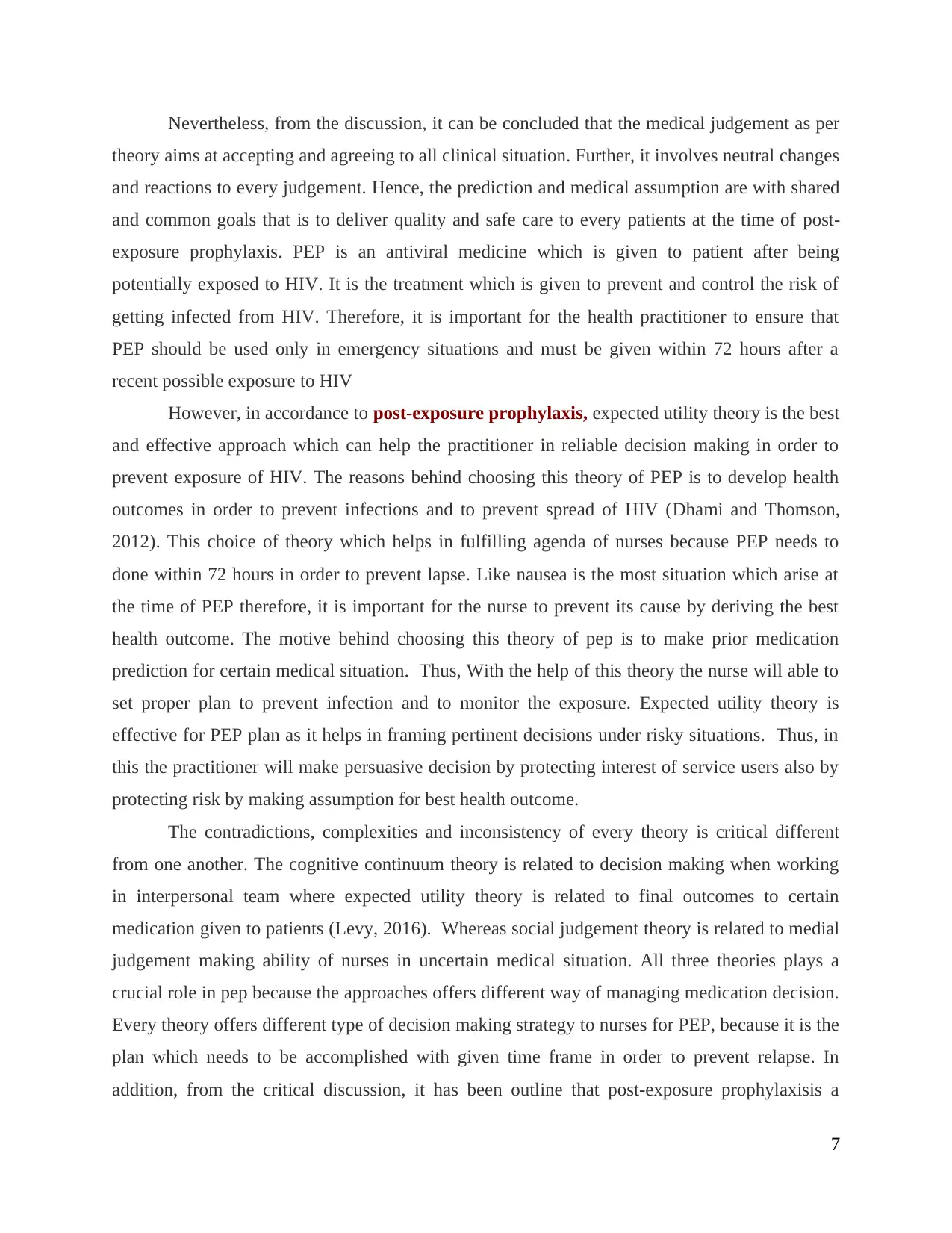
Nevertheless, from the discussion, it can be concluded that the medical judgement as per
theory aims at accepting and agreeing to all clinical situation. Further, it involves neutral changes
and reactions to every judgement. Hence, the prediction and medical assumption are with shared
and common goals that is to deliver quality and safe care to every patients at the time of post-
exposure prophylaxis. PEP is an antiviral medicine which is given to patient after being
potentially exposed to HIV. It is the treatment which is given to prevent and control the risk of
getting infected from HIV. Therefore, it is important for the health practitioner to ensure that
PEP should be used only in emergency situations and must be given within 72 hours after a
recent possible exposure to HIV
However, in accordance to post-exposure prophylaxis, expected utility theory is the best
and effective approach which can help the practitioner in reliable decision making in order to
prevent exposure of HIV. The reasons behind choosing this theory of PEP is to develop health
outcomes in order to prevent infections and to prevent spread of HIV (Dhami and Thomson,
2012). This choice of theory which helps in fulfilling agenda of nurses because PEP needs to
done within 72 hours in order to prevent lapse. Like nausea is the most situation which arise at
the time of PEP therefore, it is important for the nurse to prevent its cause by deriving the best
health outcome. The motive behind choosing this theory of pep is to make prior medication
prediction for certain medical situation. Thus, With the help of this theory the nurse will able to
set proper plan to prevent infection and to monitor the exposure. Expected utility theory is
effective for PEP plan as it helps in framing pertinent decisions under risky situations. Thus, in
this the practitioner will make persuasive decision by protecting interest of service users also by
protecting risk by making assumption for best health outcome.
The contradictions, complexities and inconsistency of every theory is critical different
from one another. The cognitive continuum theory is related to decision making when working
in interpersonal team where expected utility theory is related to final outcomes to certain
medication given to patients (Levy, 2016). Whereas social judgement theory is related to medial
judgement making ability of nurses in uncertain medical situation. All three theories plays a
crucial role in pep because the approaches offers different way of managing medication decision.
Every theory offers different type of decision making strategy to nurses for PEP, because it is the
plan which needs to be accomplished with given time frame in order to prevent relapse. In
addition, from the critical discussion, it has been outline that post-exposure prophylaxisis a
7
theory aims at accepting and agreeing to all clinical situation. Further, it involves neutral changes
and reactions to every judgement. Hence, the prediction and medical assumption are with shared
and common goals that is to deliver quality and safe care to every patients at the time of post-
exposure prophylaxis. PEP is an antiviral medicine which is given to patient after being
potentially exposed to HIV. It is the treatment which is given to prevent and control the risk of
getting infected from HIV. Therefore, it is important for the health practitioner to ensure that
PEP should be used only in emergency situations and must be given within 72 hours after a
recent possible exposure to HIV
However, in accordance to post-exposure prophylaxis, expected utility theory is the best
and effective approach which can help the practitioner in reliable decision making in order to
prevent exposure of HIV. The reasons behind choosing this theory of PEP is to develop health
outcomes in order to prevent infections and to prevent spread of HIV (Dhami and Thomson,
2012). This choice of theory which helps in fulfilling agenda of nurses because PEP needs to
done within 72 hours in order to prevent lapse. Like nausea is the most situation which arise at
the time of PEP therefore, it is important for the nurse to prevent its cause by deriving the best
health outcome. The motive behind choosing this theory of pep is to make prior medication
prediction for certain medical situation. Thus, With the help of this theory the nurse will able to
set proper plan to prevent infection and to monitor the exposure. Expected utility theory is
effective for PEP plan as it helps in framing pertinent decisions under risky situations. Thus, in
this the practitioner will make persuasive decision by protecting interest of service users also by
protecting risk by making assumption for best health outcome.
The contradictions, complexities and inconsistency of every theory is critical different
from one another. The cognitive continuum theory is related to decision making when working
in interpersonal team where expected utility theory is related to final outcomes to certain
medication given to patients (Levy, 2016). Whereas social judgement theory is related to medial
judgement making ability of nurses in uncertain medical situation. All three theories plays a
crucial role in pep because the approaches offers different way of managing medication decision.
Every theory offers different type of decision making strategy to nurses for PEP, because it is the
plan which needs to be accomplished with given time frame in order to prevent relapse. In
addition, from the critical discussion, it has been outline that post-exposure prophylaxisis a
7
⊘ This is a preview!⊘
Do you want full access?
Subscribe today to unlock all pages.

Trusted by 1+ million students worldwide
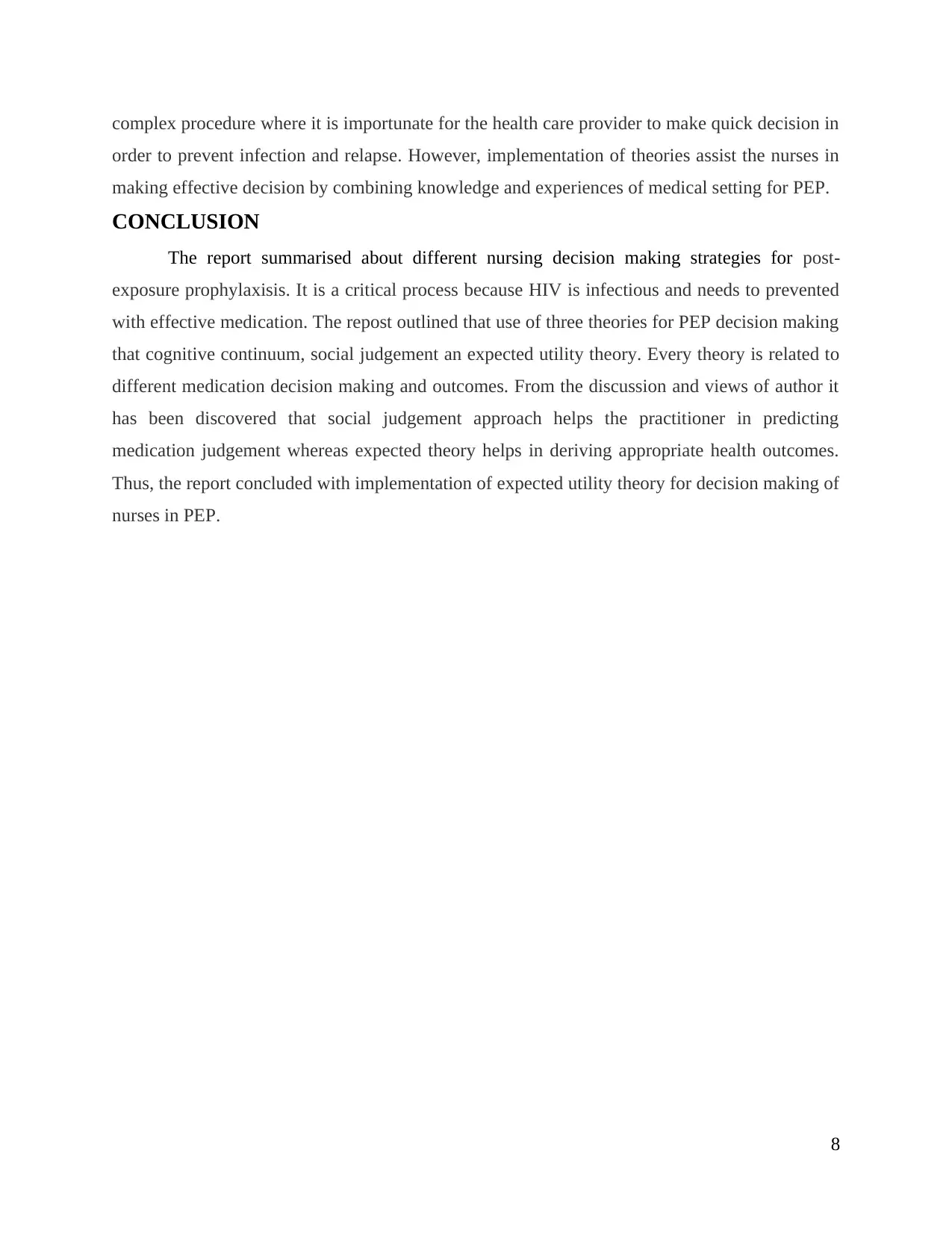
complex procedure where it is importunate for the health care provider to make quick decision in
order to prevent infection and relapse. However, implementation of theories assist the nurses in
making effective decision by combining knowledge and experiences of medical setting for PEP.
CONCLUSION
The report summarised about different nursing decision making strategies for post-
exposure prophylaxisis. It is a critical process because HIV is infectious and needs to prevented
with effective medication. The repost outlined that use of three theories for PEP decision making
that cognitive continuum, social judgement an expected utility theory. Every theory is related to
different medication decision making and outcomes. From the discussion and views of author it
has been discovered that social judgement approach helps the practitioner in predicting
medication judgement whereas expected theory helps in deriving appropriate health outcomes.
Thus, the report concluded with implementation of expected utility theory for decision making of
nurses in PEP.
8
order to prevent infection and relapse. However, implementation of theories assist the nurses in
making effective decision by combining knowledge and experiences of medical setting for PEP.
CONCLUSION
The report summarised about different nursing decision making strategies for post-
exposure prophylaxisis. It is a critical process because HIV is infectious and needs to prevented
with effective medication. The repost outlined that use of three theories for PEP decision making
that cognitive continuum, social judgement an expected utility theory. Every theory is related to
different medication decision making and outcomes. From the discussion and views of author it
has been discovered that social judgement approach helps the practitioner in predicting
medication judgement whereas expected theory helps in deriving appropriate health outcomes.
Thus, the report concluded with implementation of expected utility theory for decision making of
nurses in PEP.
8
Paraphrase This Document
Need a fresh take? Get an instant paraphrase of this document with our AI Paraphraser
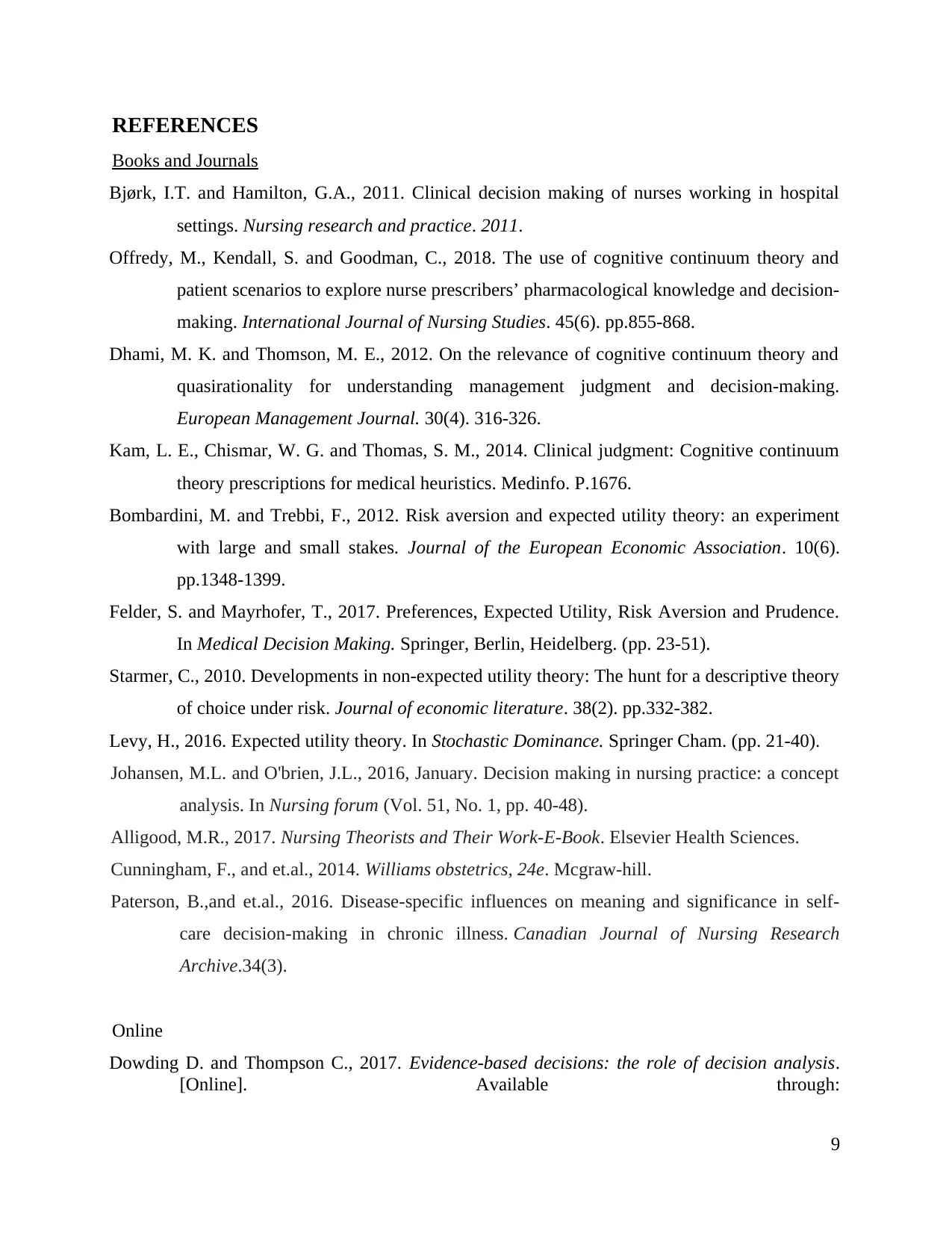
REFERENCES
Books and Journals
Bjørk, I.T. and Hamilton, G.A., 2011. Clinical decision making of nurses working in hospital
settings. Nursing research and practice. 2011.
Offredy, M., Kendall, S. and Goodman, C., 2018. The use of cognitive continuum theory and
patient scenarios to explore nurse prescribers’ pharmacological knowledge and decision-
making. International Journal of Nursing Studies. 45(6). pp.855-868.
Dhami, M. K. and Thomson, M. E., 2012. On the relevance of cognitive continuum theory and
quasirationality for understanding management judgment and decision-making.
European Management Journal. 30(4). 316-326.
Kam, L. E., Chismar, W. G. and Thomas, S. M., 2014. Clinical judgment: Cognitive continuum
theory prescriptions for medical heuristics. Medinfo. P.1676.
Bombardini, M. and Trebbi, F., 2012. Risk aversion and expected utility theory: an experiment
with large and small stakes. Journal of the European Economic Association. 10(6).
pp.1348-1399.
Felder, S. and Mayrhofer, T., 2017. Preferences, Expected Utility, Risk Aversion and Prudence.
In Medical Decision Making. Springer, Berlin, Heidelberg. (pp. 23-51).
Starmer, C., 2010. Developments in non-expected utility theory: The hunt for a descriptive theory
of choice under risk. Journal of economic literature. 38(2). pp.332-382.
Levy, H., 2016. Expected utility theory. In Stochastic Dominance. Springer Cham. (pp. 21-40).
Johansen, M.L. and O'brien, J.L., 2016, January. Decision making in nursing practice: a concept
analysis. In Nursing forum (Vol. 51, No. 1, pp. 40-48).
Alligood, M.R., 2017. Nursing Theorists and Their Work-E-Book. Elsevier Health Sciences.
Cunningham, F., and et.al., 2014. Williams obstetrics, 24e. Mcgraw-hill.
Paterson, B.,and et.al., 2016. Disease-specific influences on meaning and significance in self-
care decision-making in chronic illness. Canadian Journal of Nursing Research
Archive.34(3).
Online
Dowding D. and Thompson C., 2017. Evidence-based decisions: the role of decision analysis.
[Online]. Available through:
9
Books and Journals
Bjørk, I.T. and Hamilton, G.A., 2011. Clinical decision making of nurses working in hospital
settings. Nursing research and practice. 2011.
Offredy, M., Kendall, S. and Goodman, C., 2018. The use of cognitive continuum theory and
patient scenarios to explore nurse prescribers’ pharmacological knowledge and decision-
making. International Journal of Nursing Studies. 45(6). pp.855-868.
Dhami, M. K. and Thomson, M. E., 2012. On the relevance of cognitive continuum theory and
quasirationality for understanding management judgment and decision-making.
European Management Journal. 30(4). 316-326.
Kam, L. E., Chismar, W. G. and Thomas, S. M., 2014. Clinical judgment: Cognitive continuum
theory prescriptions for medical heuristics. Medinfo. P.1676.
Bombardini, M. and Trebbi, F., 2012. Risk aversion and expected utility theory: an experiment
with large and small stakes. Journal of the European Economic Association. 10(6).
pp.1348-1399.
Felder, S. and Mayrhofer, T., 2017. Preferences, Expected Utility, Risk Aversion and Prudence.
In Medical Decision Making. Springer, Berlin, Heidelberg. (pp. 23-51).
Starmer, C., 2010. Developments in non-expected utility theory: The hunt for a descriptive theory
of choice under risk. Journal of economic literature. 38(2). pp.332-382.
Levy, H., 2016. Expected utility theory. In Stochastic Dominance. Springer Cham. (pp. 21-40).
Johansen, M.L. and O'brien, J.L., 2016, January. Decision making in nursing practice: a concept
analysis. In Nursing forum (Vol. 51, No. 1, pp. 40-48).
Alligood, M.R., 2017. Nursing Theorists and Their Work-E-Book. Elsevier Health Sciences.
Cunningham, F., and et.al., 2014. Williams obstetrics, 24e. Mcgraw-hill.
Paterson, B.,and et.al., 2016. Disease-specific influences on meaning and significance in self-
care decision-making in chronic illness. Canadian Journal of Nursing Research
Archive.34(3).
Online
Dowding D. and Thompson C., 2017. Evidence-based decisions: the role of decision analysis.
[Online]. Available through:
9

<http://booksite.elsevier.com/samplechapters/9780443067273/9780443067237_11.pdf>
.
Moscati I., 2017. Expected utility theory and experimental utility measurement, 1950–1985.
From confidence to scepticism. [Online]. Available through:
<https://www.tandfonline.com/doi/abs/10.1080/09672567.2017.1378692>.
The use of cognitive continuum theory and patient scenarios to explore nurse prescribers'
pharmacological knowledge and decision-making. 2008. [Online]. Available through:
<https://www.ncbi.nlm.nih.gov/pubmed/17362959>.
10
.
Moscati I., 2017. Expected utility theory and experimental utility measurement, 1950–1985.
From confidence to scepticism. [Online]. Available through:
<https://www.tandfonline.com/doi/abs/10.1080/09672567.2017.1378692>.
The use of cognitive continuum theory and patient scenarios to explore nurse prescribers'
pharmacological knowledge and decision-making. 2008. [Online]. Available through:
<https://www.ncbi.nlm.nih.gov/pubmed/17362959>.
10
⊘ This is a preview!⊘
Do you want full access?
Subscribe today to unlock all pages.

Trusted by 1+ million students worldwide
1 out of 12
Related Documents
Your All-in-One AI-Powered Toolkit for Academic Success.
+13062052269
info@desklib.com
Available 24*7 on WhatsApp / Email
![[object Object]](/_next/static/media/star-bottom.7253800d.svg)
Unlock your academic potential
Copyright © 2020–2025 A2Z Services. All Rights Reserved. Developed and managed by ZUCOL.




